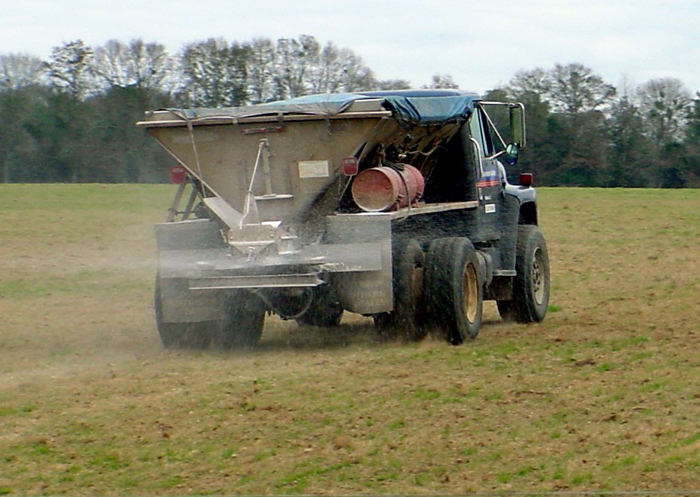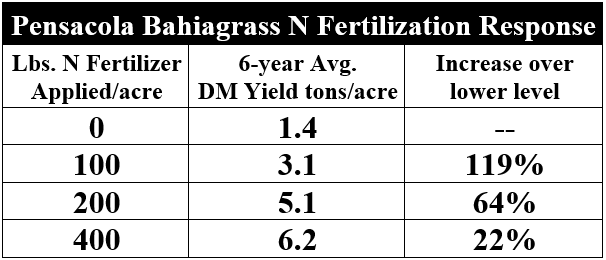One area of management that often comes up in discussions with producers managing smaller herds is pasture fertilization. There are several aspects that can be confusing. The first questions are, “Should I fertilize?” and, “Is it worth the money?” The next question is, “How much fertilizer do I need?” And generally, the final question, “What should I ask my supplier for?” When you ask these questions, however, be ready for the return question, “Have you taken a soil test?”
In declining cattle markets, the question of “Should I fertilize?” is a subject of much debate. You don’t have to fertilize bahiagrass pastures, but there are consequences if you don’t adjust your stocking rate. If you don’t fertilize or reduce your stocking rate, there may not be enough grass in the fall transition, and eventually there will be issues from thinning stands and weed encroachment.
Soil pH
Basic soil management for forages, or any crop, requires that the soil be maintained in the optimal pH range for the specific target crop to ensure productivity and persistence. For tropical forages, such as Bahiagrass, Bermudagrass, and Limpograss the optimal pH range is 5.0-5.5. Outside of the optimal pH range, soil nutrients are less available to the plant. This is one of the key reasons that periodic soil testing is recommended for pastures. Lime or dolomite are utilized interchangeably to raise the soil pH. Liming pastures is relatively inexpensive because it is generally only required every 2-4 years.
So, should you fertilize? If the soil pH falls below the optimal range, the answer is yes. For $40 per ton, the return on investment in lime or dolomite is high. If you do nothing else for your pastures this year, make sure to lime the Bahia and Bermuda fields that fall below 5.5, or limpograss fields below 5.0. If you can’t remember how long ago you had your soil tested, send in a soil sample, and and at least find out the pH status of your pastures.
Nitrogen
Soil tests don’t provide the amount of nitrogen in the soil, because those amounts are constantly changing. Nitrogen (N), and to some degree potassium (K), move with water in the soil profile. With each heavy rain, some nitrogen is flushed down through the soil profile, away from the root zone of plants. There are 16 essential elements for plant growth and reproduction, but nitrogen is the key element that plants require for growth. In other words, “Nitrogen is the gas that makes grass grow!” The chart below is the summary of a classic six-year study conducted a the UF Beef Research Unit from 1966-71 by W.G. Blue, UF Soil Chemist: Role of Pensacola Bahiagrass Stolon-Root Systems in Leon Fine Sand.
What is interesting from this study is that the season-long forage yield more than doubled when 100 lbs.N/acre was applied as compared to no added N. However, with each increase beyond 100 lbs.N/acre, the return on investment diminished. It is important to note that all of the plots were fertilized equally with phosphorous and potassium, at a soil pH of 6.0, so the yield in the 0 N, or control plots, were only limited by the lack of nitrogen. These research plots received split applications of fertilizer, so none of these treatments were a single N application. This classic study shows what numerous others have shown since then, that nitrogen fertilization generates a significant boost to bahiagrass production.
Urea fertilizer (46% N) is currently priced at an average of $414/ton, which equates to 45¢/lb. of elemental N. The reported 119% season-long increase in forage production per acre would require a $45 investment in nitrogen fertilizer today. When you add the $7/acre cost to spread the fertilizer, and you have a stocking rate of 2 acres per cow-calf pair, the total cost is $104 per pair ($52/acre). So, based on the data from this classic study, a $104 investment provided 3.4 tons more feed per pair over the entire growing season for a unit cost of $31/ton. At the end of April, good quality Bermudagrass hay was selling for an average of $90/ton, and whole cottonseed $158/ton, so this is considerably cheaper than purchase feeds. This is also feed that requires limited labor to provide, with minimal waste, under typical weather conditions. In addition, fertilized grass provides more protein than unfertilized grass, so animal performance (gain/acre) would also be boosted, as compared to unfertilized pastures.
If you don’t have the funds to invest $52/acre for all of your pasture acreage, then consider applying only of 50 lbs.N/acre in the spring. You don’t have to fertilize every acre either. Invest in your most productive pastures first, and then rotate to other pastures in future years. Fertilizer is an expensive purchase, and when cattle prices are falling, every purchasing decision has to be scrutinized. The bottom line is that nitrogen fertilizer is really an investment in producing feed for your herd that they harvest for themselves. Conversely, if you make the decision to eliminate nitrogen fertilization, your pasture will produce less feed, so you also need to reduce the number of cattle your pastures are expected to feed.
P & K Fertilization
The next question is how much P & K fertilizer do you need for your bahiagrass pastures? In general, grasses need N-P-K fertilizer in a 4-1-2 ratio. So, you would not want to use 13-13-13 or 10-10-10 for grass pastures, but instead something like a mix of 16-4-8 or 20-5-10. The better option, however, is to send in a soil and tissue sample to get a lab test report that provides specific recommendations for the rate of lime, phosphorous (P) and potassium (K) fertilization on a per acre basis. The N fertilization level is a decision the manager has to make. The University of Florida’s soil test-based fertilizer recommendations provide options for three levels of nitrogen fertilization. The recommendations for P and K will be different based on the nitrogen fertilization level you select.
Purchasing Fertilizer
The final question I normally get is, “What should I order from my farm supply dealer?” This does sometimes get confusing, because recommendations are made in pounds of nutrients per acre, not the total pounds of fertilizer. Urea, for example, is only 46% elemental nitrogen, so it takes 109 pounds of urea to provide 50 lbs.N/acre. Ammonium nitrate is 34% N, so it takes 147 pounds to reach the 50 lbs.N/acre target. The same is true for the various sources used for P and K. Farm supply dealers handle a variety of products from different sources with varied mineral make up. There is no standard recipe. Take your soil test recommendations with you, so your dealer can help you do the calculations as to the total pounds of the blended fertilizer you want applied.
If you have questions about pasture fertilization, soil and tissue testing, or the soil test report recommendations, contact your local UF/IFAS County Extension Agent. Make sure you clearly understand the options, before making an investment of this magnitude.
 1
1


